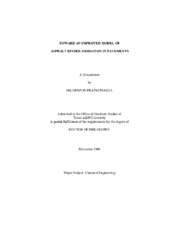| dc.description.abstract | Asphalt binder oxidation in pavements has been proven to be an ongoing process
throughout a pavement's service life. Understanding the nature of the oxidation process
is a critical step toward better pavement design to achieve greater pavement durability.
The main component in asphalt binder oxidation in pavements is binder oxidative
hardening. As the aromatic compounds in asphalt binders are oxidized, more polar
carbonyl compounds are created, which results in stronger associations between asphalt
components and eventually leads to an increase in asphalt elastic modulus and viscosity.
Consequently, the performance of pavements is affected directly by asphalt binder
hardening.
Also, low levels of accessible air voids in pavements potentially relate to binder
oxidation according to a recent research study. When the pavements have sufficiently
high accessible air voids (4 percent or greater), the oxidation rate is largely determined
by the temperature in the pavement. On the other hand, when the percentage of
accessible air voids in the pavement is considerably lower (2 percent or less), the
hardening rate of binders in pavements is reduced significantly.
Field evidence is mounting that asphalt binder oxidization in pavements produces
a binder that is more susceptible to thermal and fatigue cracking. While the
fundamentals of this oxidation process are fairly well known, predicting quantitatively
the rate of oxidation as a function of depth in the pavement, is not straightforward. A
thermal and oxygen transport model, coupled with binder reaction kinetics, provides the basis for such calculations. A one-dimensional thermal transport model, coupled with
site-specific model parameters and recent improvements in the availability of required
input climate data, enables calculation of pavement temperatures throughout the year,
which then is used in an asphalt binder oxidation and transport model to calculate binder
properties in the pavement over time. Calculated binder property changes with depth and
time are compared to measurements of binder oxidation in the field.
The work in this study is aimed at understanding the oxidation kinetics of asphalt
binders in pavements, determining the impact of accessible air void levels on asphalt
hardening, and ultimately developing an improved model of asphalt binder oxidation in
pavements. | en |


